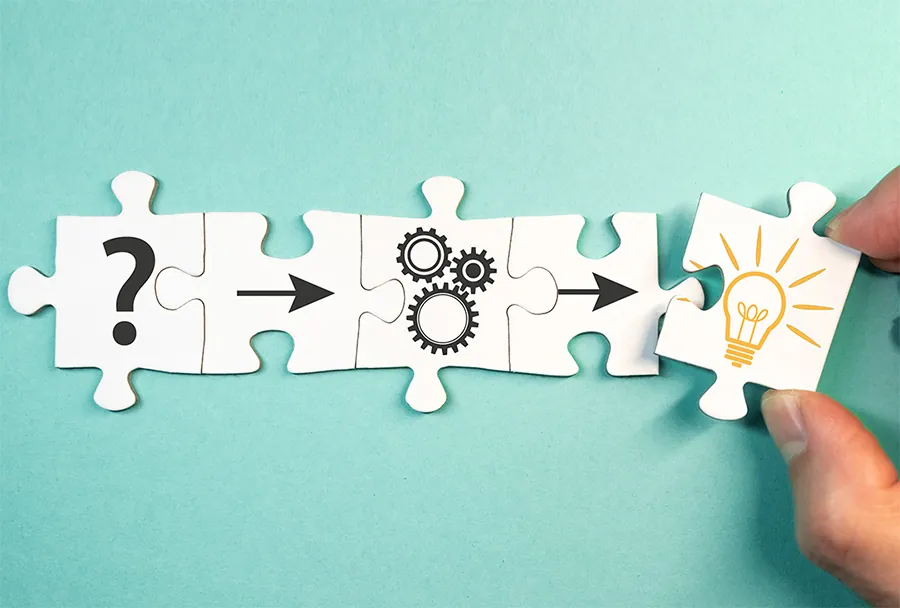Using No to Get to Yes

Do you remember the last time you were solicited by a salesperson at a kiosk in your local mall? On a recent mall visit, I walked past a kiosk and the salesperson asked, “Can I ask you a question?” I replied, “No thanks” and kept walking. As a sales trainer and coach, the question got me thinking that this scenario is similar to cold outreach in a business–to–business environment. Why did I shut down the conversation before it started and what could the salesperson have done differently? In this article we explore why prospects say “No” and how salespeople can better position themselves for success.
Why Do We Say No
I have no idea what the product the salesperson was selling when she approached me. I believe it was skincare or hair care products, but I did not look at the display to verify what it was. I did notice her at the booth, and thought, “Here comes a sales pitch.” Because I was in a hurry and trying to get in and out of the mall as fast as possible, the “no” response just rolled off my tongue without much thought.
This situation is not unlike a decision-maker at a prospective company who is being targeted by a salesperson. The decision-maker showed up to work for a specific reason. They have specific goals they want to accomplish and initiating an unplanned conversation with a salesperson is a distraction. If a salesperson is lucky enough to get past the gatekeeper and then asks the decision-maker if they caught them at a good time, they will often get an immediate “no” response. Just like my no reply to the kiosk salesperson.
This immediate no is often instinctual and emotional, but not rational. I don’t know the psychology behind it, but if I take an educated guess, I would say it is survival related. As humans, we don’t like the feeling of being trapped, or corralled. We naturally resist attempts to be boxed in. The “no” response has less to do with the question, (we don’t even know what the product is or the benefit to us), and more to do with protecting ourselves. In other words, the initial no is a safe answer.
As salespeople, we have been trained to avoid no. No is the enemy. We want our prospects to say “yes.” When we hear a no, we have to rebut or try to influence the prospects thinking. The effort rarely is successful. The harder we push, the more the prospect resists. For salespeople, when prospects say “No,” it usually marks the end of the conversation.
- Do you have time for a quick call? No.
- Are you interested in learning about XYZ? No.
- Did you have a chance to review my last email? No.
Prospects reply with “No” without thinking. It’s a reflex because it keeps them safe. As prospects, even us sales coaches don’t want to be dragged into an unplanned conversation. By saying “no,” we stay in control and alleviate that feeling of being trapped. In general, early on in a sales call, prospects will feel unsure, skeptical, and hesitant. The “no,” which so quickly rolls out of our mouths, is not a specific no to a product or no to a service or no to you as the salesperson. It is a catch-all “no” as in, “I don’t want to be troubled right now.” This “no” response keeps us safe and secure.
Even though the buyer feels safe, it creates a totally different feeling for the salesperson. When we receive a “no” response, it creates resistance. Any time prospects disagree with us, it creates resistance.
As salespeople, we want to create agreement, not resistance. Agreement creates an emotional bond that brings people together. In an outdated sales methodology, reps were taught to ask a series of “Yes” questions. The reasoning was to create artificial agreement and get the prospect to bond with the salesperson.
- Are you interested in growing revenue? Yes.
- Are you interested in saving money? Yes.
- Are you interested in saving time? Yes.
In modern sales situations, sophisticated buyers quickly recognize this as a manipulative sales tactic. Instead of creating agreement, the buyer will feel like they are being exploited, leading to resistance or even frustration and anger. Either way, starting the initial conversation off with resistance or frustration does not improve the probability of success.
Reverse the Negative
When salespeople approach us out of the blue, whether in the mall or over the telephone, it is a normal response to feel uncomfortable. When our brain picks up the “here comes a sales pitch” vibe, we go into protection mode. The brain says, “Be careful, don’t get yourself into something you’ll regret.” It’s not until we disarm protection mode that we will have a natural or “non-protective” conversation. As long as the prospect is in protection mode, the safe answer will be “no.”
If we reverse the negative of “no,” we can leverage the prospect’s response in our favor. In other words, the prospect will likely still provide a “no” response that feels safe to them, but at the same time creates agreement and an opportunity to start a conversation. For example:
- Are you familiar with our product? No.
- Do you think selling will get easier next quarter? No.
- Have you given up on saving time? No.
Chris Voss, a former FBI hostage negotiator, points out that providing “yes” means implied commitment. When you reverse engineer the negative, like multiplying two negative numbers, you get a positive. Other examples where you could reverse the negative of “no” and create a positive include:
- Are you against sales training?
- Have you given up on improving sales?
Another example where reversing the negative could be effective is when a salesperson is following up with a prospect who has gone dark and is not responding. For example, say you’ve been following up and the prospect won’t return your calls or emails. You could send an email with the headline:
- Nick, Did I drop the ball?
- Nick, Did I let something fall through the cracks?
As the salesperson, you know you did not drop the ball, but you want the prospect to feel safe. Giving the prospect the ability to say “no” is safe. It also gives the prospect a chance to correct you. A common reply is “No, it’s not your fault, I’ve been on vacation.” By providing a prospect who goes dark with the ability to say “No,” you lower the resistance felt in the conversation.
An additional sales situation where reversing the negative could be an effective strategy is when following up with previous prospects who rejected your offer. For example, if your company sells software, you could position the “no” question as:
- Did you see our recent software upgrade?
- Are you familiar with our new software enhancements?
- Did you know we re-designed our User Interface?
The key takeaway from asking the reverse negative questions is that they require a little thinking. Most salespeople spend all their time trying to figure out what to say to prospects. With the reverse negative questions, salespeople will need to invest their time and figure out what to ask.
In Conclusion
The earlier in the sales process you are with a cold prospect, the more resistance the prospect is likely to feel in the conversation. You as the salesperson may be eager to ask questions, but if the prospect is more comfortable answering with “no,” creating no questions can be an effective change of pace. By recognizing no as the natural condition we can create negative questions that allow the prospect to say “no” to our questions, but still create agreement.
Final question, “Do you think it’s impossible to ask questions prospects want to respond to?
If your answer was no, you could be on to something.
Comments are closed.

- Account Planning (12)
- Awards (44)
- Client Testimonial (37)
- Personal Branding (21)
- Podcast (12)
- Research (78)
- Sales Career Development (90)
- Sales Coaching (166)
- Sales Consulting (141)
- Sales Culture (180)
- Sales Enablement (382)
- Sales Leadership (116)
- Sales Management (267)
- Sales Negotiation (14)
- Sales Prospecting (138)
- Sales Role-Playing (19)
- Sales Training (243)
- Selling Strategies (281)
- Soft Skills (78)
- Talent Management (101)
- Trusted Advisor (29)
- Virtual Selling (57)
- Webinar (13)


























Hello
I like the reverse phycology when dealing with prospects who many times as you say, their quick way out is no or not interested. Finding that crack in the door can create an opportunity.
Thank you